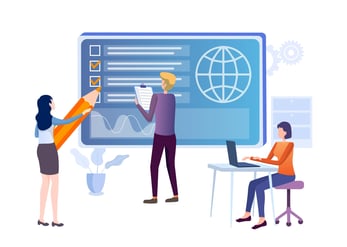3 unplanned but common challenges faced when doing data transitions and how best to overcome them
Global energy transition is at the forefront of discussions within the oil and gas industry and at ABL, we believe one of the main drivers of how companies successfully manage this transition is reliable, accurate data. Having worked with a variety of cross-industry clients over the years, we have seen similar unplanned challenges arise when completing data transitions and transformations.
Below are some of the main challenges that our Head of Technical, Stuart Murray, has highlighted, as well as his recommendations on how to overcome them.
Common challenges faced when doing data transitions and transformations
1. Assuming that data is of a high standard and completeness
“It is important to actually look at your data and understand it, not simply trust that ‘someone’ has managed it. We’ve seen some worrying trends across the whole globe, not just in oil and gas but also across power generation where make, model, and manufacturing numbers for equipment have not been in place to levels anywhere between 50% to 5% population.”
2. Lack of budget and time to plan and risk assess the transition
“A data transition can either be a massive problem or a massive benefit depending on how you conduct it. We often see ambiguity in who actually owns the data, some see it as an IT job, others see it as a maintenance job, but in reality, everyone uses data. There’s finance, procurement, warehousing, and all sorts of people involved in the transition, and if this is not planned and risk assessed ahead of time then it can have detrimental effects on the whole business.”
3. No shared understanding of the importance of data within the business
“We often see an absence of company KPIs set around data quality. It’s important to think about how different departments interact within your business and ensure they share the same understanding of how important their roles are in the overall picture of managing data. Picture a rugby team on a pitch, there is not just one individual player holding the ball at all times, it’s about how well you throw the pass between each other, and how well it is received. Data is much the same, you need to ensure you are handing information over to people in an effective way.”

How to overcome these challenges
1. Understand your current position and future aspirations
“A good analogy to help clearly envision a data transition is to think of it like moving house. The first things you need to do are figure out what you have and what your aspirations are for the move. What are you going to take with you? Are you going to move yourself or pay for movers? From a business point of view, try to understand your business goals and what your current situation truly is. Do you want to lower emissions and aim for target zero? How do you prove that you’re making progress? Are you going to use the circle economy and aim to recycle? Look at your asset and decide which ones could be reused for carbon capture, what condition are they in, and are they fit for purpose? If you’re not recording your data well then this all becomes a problem during the transition, knowing what and where to move data.
“Management consultant and author, Peter Drucker, famously said, “There is surely nothing quite so useless as doing with great efficiency what should not be done at all”. Before you jump into your data transformation/transition, you must understand your change driver. Why is this change in your data needed? For example:
- Do you have a new asset?
- Are you merging with other entities?
- Is there an update to your existing CMMS system?
- Are you going through a recommissioning process?
“When you move from one master data system to another, you want to ensure that you’re in a better position than you were before. In terms of the moving house analogy, you wouldn’t bring old clothes that you never wear, so do you need to bring all of your outdated and obsolete data?”
2. Compile your Data Standards
“Begin with reviewing your data standards and be honest with yourself about whether you have a complete Data Standard that covers all your assets or not. With monumental amounts of data now available, it is easy to find yourself drowning in a data lake filled with rubbish, so try and understand what you really need.
“Write down how you are going to use your data both overall and within each department. This will not only help when conducting data standards creation, review, and issuing, but it will also give departments a sense of ownership and responsibility over the master data.”

3. Find a way to manage the data change
“Thinking back to the moving house analogy, ask yourself who is going to do the moving? Will you hire a van or use your own car to do it yourself, or will you hire movers and packers and hand that responsibility across. One way to efficiently manage a data change is to find an asset management strategy deployment tool such as EffioTM that can deliver:
- Storage of the data standard/rules
- Linking of data across departments
- Understanding of data quality and gaps
- Means to close gaps and monitor progress
- Visibility of data to users and transition team
- Log of changes, ensuring auditable trail is in place
- Process management and recorded sign-off
- Accessibility for all stakeholders
- Secure and managed access
4. Validation
“After the data transition has taken place, it’s important to look back and determine what was successful and what wasn’t. Validation should be considered at the very beginning of the process in order for the results to be accurate as possible. We have found that the best ways to evaluate whether the new system is working as it should are as follows:
- Determine your Key Performance Indicators of success
- Capture your starting point in order to measure improvements and return on investment
- Seek approval from stakeholders

“Test the hand over points and data interactions just as you would if physical equipment was being installed and ensure that all the agreed data rules translate to the ‘LIVE’ system. Remember that people are the most important driver when it comes to data. Ask whether the data users understand the new system and make a point to ensure they are coping with the change.
“Finally, after this validation process, make sure the support plan is modified based on the feedback you have received.”
At ABL, our team of multidisciplinary master data build experts can transact in multiple CMMS’, EAMs and ERPs and are conversant in SAP, Maximo, IFS, Engica, AMOS and others.
We offer full flexibility in our approach to delivering master data solutions for new and existing operational plants through the following delivery models:
- Do it for you
- Do it with you
- License our software to you
- Advise you
